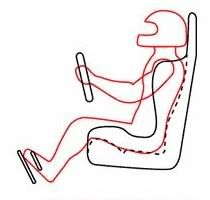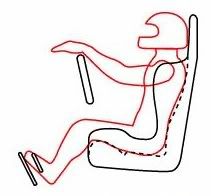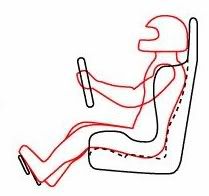hey, i was diggin through my bookmarks...thought i post this up
Seating Position
One of the first things to prepare before you even turn the key, is a proper seating position. This is often overlooked, or improperly immitated, resulting in poorer car control and premature fatigue.

First, sitting in the seat itself, the driver's back should be flat against the back of the seat with the buttocks squarley tucked into the corner created at the intersection of the seat back and bottom. The underside of the legs should be in contact with the seat bottom. The purpose of this position is to provide as much surface contact between the driver's body and the seat. This has safety benefits as well as providing the driver with the most tactile feedback as possible.

Second is the arm position. When the driver is tightly strapped into the seat as described above, the arms when fully extended should allow the wrists to rest at the top of the steering wheel. This allows the arms to be slightly bent at the elbow when fully extended for a turn. The purpose of this position is to prevent the arms from being overextended during turns (the shoulders should not need to lift from the seat back even to do a full arm crossover). Overextending the arms will cause them to tire quickly, and will cause the driver to lose sensitivity to the vibrations in the steering wheel.

Third is the leg position. When any of the pedals are fully depressed with the ball of the foot on the pedal (not the toes), the leg should still be bent at the knee. This is to prevent overextension as described for the arms. Additionally, given that most hobbists are driving their street cars, be sure that the knees are not against the underdash or steering column. In fact, there should be several inches room to prevent injury in event of a collision. The right leg in particular will need enough knee room to allow the ball of the foot to be on the brake pedal, and the heel to be on the gas pedal for heel-toe downshifting.
All content belongs to © 2000-2005, TurnFast.com
Seating Position
One of the first things to prepare before you even turn the key, is a proper seating position. This is often overlooked, or improperly immitated, resulting in poorer car control and premature fatigue.

First, sitting in the seat itself, the driver's back should be flat against the back of the seat with the buttocks squarley tucked into the corner created at the intersection of the seat back and bottom. The underside of the legs should be in contact with the seat bottom. The purpose of this position is to provide as much surface contact between the driver's body and the seat. This has safety benefits as well as providing the driver with the most tactile feedback as possible.

Second is the arm position. When the driver is tightly strapped into the seat as described above, the arms when fully extended should allow the wrists to rest at the top of the steering wheel. This allows the arms to be slightly bent at the elbow when fully extended for a turn. The purpose of this position is to prevent the arms from being overextended during turns (the shoulders should not need to lift from the seat back even to do a full arm crossover). Overextending the arms will cause them to tire quickly, and will cause the driver to lose sensitivity to the vibrations in the steering wheel.

Third is the leg position. When any of the pedals are fully depressed with the ball of the foot on the pedal (not the toes), the leg should still be bent at the knee. This is to prevent overextension as described for the arms. Additionally, given that most hobbists are driving their street cars, be sure that the knees are not against the underdash or steering column. In fact, there should be several inches room to prevent injury in event of a collision. The right leg in particular will need enough knee room to allow the ball of the foot to be on the brake pedal, and the heel to be on the gas pedal for heel-toe downshifting.
All content belongs to © 2000-2005, TurnFast.com
